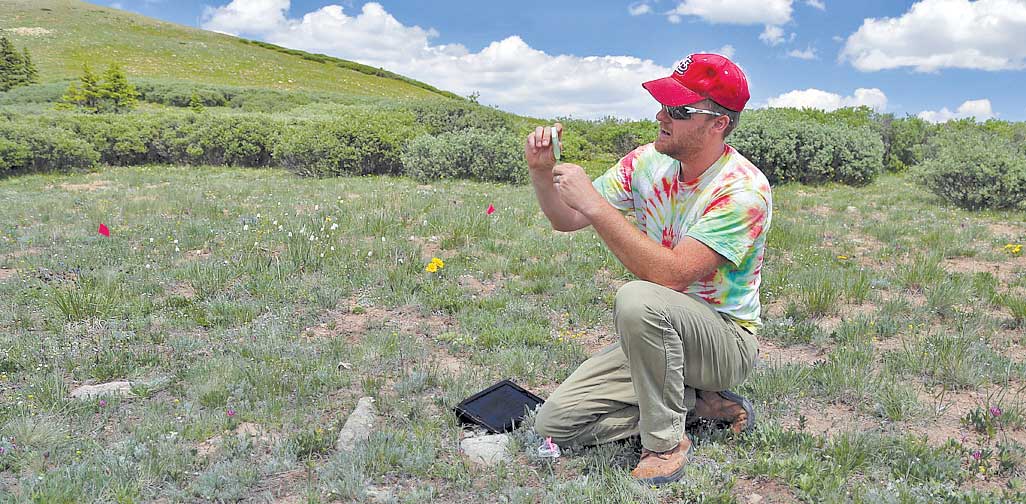by Jane Koerner
Pennsylvania Mountain may be too modest in contour and elevation to compete with the fourteeners of international renown, but the biologists don’t complain. While hundreds of hikers elbow their way up the highest peaks of the Mosquito Range, the scientists inspect their decades-old tundra plots relatively undisturbed. On the ridge below their tagged plants, 1,800 year-old bristlecones contort the well-traveled pathway. In the valley to the northeast, beaver ponds along Pennsylvania Creek testify to a work ethic that would put our Puritan forebears to shame, benefitting wildlife and humans alike.
 But like the rest of the range, Pennsylvania Mountain has not escaped the consequences of the gold and silver rushes of the late 1800s, nor the real estate booms of more recent times. On one side of the mountain overlooking Hwy. 9 between Alma and Fairplay, active and abandoned mining claims have left a bevy of roads and gravel pits in their wake. Further south, a subdivision has encroached on ancestral elk and bighorn sheep habitat. Dirt roads crisscross the steep forest, linking one private property after another to the next. No-trespassing signs and barbed-wire fences endanger public access to popular hiking and backcountry skiing routes to the summit.
But like the rest of the range, Pennsylvania Mountain has not escaped the consequences of the gold and silver rushes of the late 1800s, nor the real estate booms of more recent times. On one side of the mountain overlooking Hwy. 9 between Alma and Fairplay, active and abandoned mining claims have left a bevy of roads and gravel pits in their wake. Further south, a subdivision has encroached on ancestral elk and bighorn sheep habitat. Dirt roads crisscross the steep forest, linking one private property after another to the next. No-trespassing signs and barbed-wire fences endanger public access to popular hiking and backcountry skiing routes to the summit.
Given the money to be made from land sales in the Colorado Rockies, the temptation to keep subdividing is irresistible. To prevent that from happening, the nonprofit Mountain Area Land Trust in Evergreen, Colorado, has purchased 92 undeveloped acres, increasing the total protected to 500 acres. In its mission to safeguard public access and vulnerable wetlands, forest and tundra, the land trust has partnered with other landowners; the U.S. Forest Service; the University of Colorado-Colorado Springs, which has been conducting research on the mountain for decades; and a private property owner who donated his holding. The Mosquito Range Heritage Initiative is supporting the project with manpower for plant surveys, publicity, fundraisers and public forums for developing a management plan.
Since purchasing the acreage in December 2013 for $200,000, the land trust has been surveying the site for historical and ecological assets. They have also begun monitoring the site for illegal roads and buildings. But the highest priority for now is the management plan to be developed in consultation with biologists, outdoor recreationalists and other stakeholders. In addition to the management plan, the trust hopes to raise enough money to buy another sizeable plot that, if developed, would cut off public access.
The land trust has brokered conservation easements not only for threatened habitat and open space in half a dozen mountainous counties, but for working ranches such as the Long Meadow Ranch on the North Fork of the South Platte River in Park County. Pennsylvania Mountain Natural Area is their first land purchase and most ambitious undertaking yet.
The partnership with university researchers reinforces the land trust’s educational objectives. “We want to teach people to take care of the land before it’s too late,” development director Betsy Hays told The Denver Post.
One of the experts who can help further that goal is biologist Candace Galen of the University of Missouri, who has been studying the pollination strategies of alpine sky pilots for more than 35 years. By mid-June, its purple flowers blossom with a skunkish scent that attracts queen bumblebees and repels sterilizing pests. In a win-win relationship that evolved over the millennia, the flower’s nectar nourishes the bee, ensuring its survival for the time being and the transfer of pollen to a suitable mate. With only one reliable pollinator in its survival kit and a host of potential parasites, the sky pilot’s toehold above timberline can be easily dislodged. Galen and her graduate students are already noticing the impact of climate change. As nighttime and winter temperatures rise, and timberline climbs, queen bumblebees must contend with rivals from lower elevations. How this increased competition will play out over time is well worth investigating, Galen says; knowledge may produce tools for defending biodiversity from the shorter-lived snowpacks, extreme heat waves, drought and precipitation of climate change.
To see Pennsylvania Mountain’s biological and historical riches for yourself, sign up for a free, guided nature hike. These hikes are offered two to three times a month throughout the summer until Saturday, Aug. 30. For the schedule, go to www.savetheland.org/hiking-with-malt. To reserve your space, call 303-679-0950. You can request a specific date.
After the hike, weather permitting, the summit may beckon. At just over 13,000 feet high, Pennsylvania’s spacious high point is often bypassed for the glory of standing atop Mount Bross or Lincoln or Sherman. With plenty of elbow room for a leisurely rest break, you can take your time (unless a storm is brewing) and, gazing up at the infinite sky, contemplate your microscopic niche in the cosmos as the conquering peak baggers march on the nearby fourteeners. On the way down, please respect the painstaking labor of the biologists and their students, and tread lightly through the tundra. The intricate dance between wildflower and insect requires the cooperation of the mother of all mammals – us.
Jane Koerner of Fairplay, has been writing about the intermountain West for 30 years.
Photos courtesy of the Mountain Area Land Trust.



